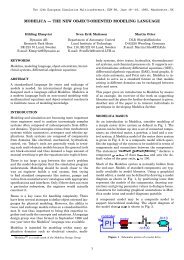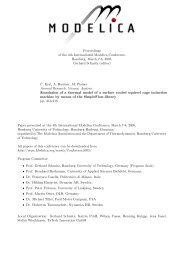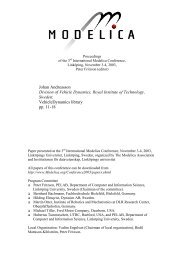Dynamic modelling of a combined cycle power plant with ... - Modelica
Dynamic modelling of a combined cycle power plant with ... - Modelica
Dynamic modelling of a combined cycle power plant with ... - Modelica
Create successful ePaper yourself
Turn your PDF publications into a flip-book with our unique Google optimized e-Paper software.
Using dynamic models for <strong>combined</strong> <strong>cycle</strong> <strong>power</strong><br />
<strong>plant</strong>s (as well as for any other type <strong>of</strong> <strong>power</strong> <strong>plant</strong>s)<br />
allows to go beyond the study <strong>of</strong> fixed set points to:<br />
- check precisely the performances and the design<br />
given by the manufacturers (commissioning),<br />
- verify and validate by simulation the scenario <strong>of</strong><br />
large transients such as gas turbine trips,<br />
- find optimised operating points,<br />
- find optimised operation procedures,<br />
- perform local and remote <strong>plant</strong> monitoring,<br />
- build correction curves,<br />
- etc.<br />
In order to challenge the dynamic simulation capabilities<br />
<strong>of</strong> the library, a step load variation from<br />
100% to 50% and a turbine trip (sudden stopping <strong>of</strong><br />
the gas turbine) were simulated.<br />
2 Introduction to ThermoSysPro<br />
2.1 Objectives <strong>of</strong> the library<br />
From the end-user’s viewpoint, the objectives <strong>of</strong> the<br />
library are:<br />
- Ability to model and simulate thermodynamic<br />
processes.<br />
- Ability to cover the whole life<strong>cycle</strong> <strong>of</strong> <strong>power</strong><br />
<strong>plant</strong>s, from basic design to <strong>plant</strong> operation and<br />
maintenance. This implies the ability to model<br />
detailed subsystems <strong>of</strong> the <strong>plant</strong>, and to model<br />
the whole thermodynamic <strong>cycle</strong> <strong>of</strong> the <strong>plant</strong>, including<br />
the I&C system.<br />
- Ability to initialize the models for a given operating<br />
point. This is essentially an inverse problem:<br />
how to find the physical state <strong>of</strong> the system<br />
given the values <strong>of</strong> the observable outputs <strong>of</strong> the<br />
system.<br />
- Ability to perform static calculations (for <strong>plant</strong><br />
monitoring and <strong>plant</strong> performance assessment)<br />
and dynamic calculations (for operation assistance)<br />
faster than real time.<br />
- Ability to fit the <strong>plant</strong> models against real <strong>plant</strong><br />
data using for instance data assimilation techniques.<br />
- Ability to use the models to improve the quality<br />
<strong>of</strong> measurements using the data reconciliation<br />
technique.<br />
- Ability to use the models for uncertainty studies<br />
by propagating uncertainties from the inputs to<br />
the outputs <strong>of</strong> the model.<br />
From the model developer’s viewpoint:<br />
- The library should be easy to read, understand,<br />
extend, modify and validate.<br />
- The library should be sharable at the EDF level,<br />
and more.<br />
- The library should be truly tool independent.<br />
- The library should be stable across language and<br />
tools versions.<br />
- The library should be validated against significant<br />
real applications.<br />
- The library should be fully documented. In particular,<br />
all modeling choices should be clearly<br />
justified.<br />
2.2 General principles <strong>of</strong> the library<br />
The library features multi-domain modeling such as<br />
thermal-hydraulics (water/steam, flue-gases and<br />
some refrigerants), neutronics, combustion, solar<br />
radiation, instrumentation and control.<br />
The library is founded on first physical principles:<br />
mass, energy, and momentum conservation equations,<br />
up-to-date pressure losses and heat exchange<br />
correlations, and validated fluid properties functions.<br />
The correlations account for the non-linear behaviour<br />
<strong>of</strong> the phenomena <strong>of</strong> interest. They cover all water/steam<br />
phases and all flue gas compositions. Some<br />
components such as the multifunctional heater contains<br />
correlations that were obtained from experimental<br />
results or CFD codes developed by EDF. An<br />
early <strong>Modelica</strong> implementation <strong>of</strong> the IAPWS-IF97<br />
standard by H. Tummescheit is used for the computation<br />
<strong>of</strong> the properties <strong>of</strong> water and steam.<br />
The level <strong>of</strong> <strong>modelling</strong> detail may be freely chosen.<br />
Default correlations are given corresponding to the<br />
most frequent use-cases, but they can be freely modified<br />
by the user. This includes the choice <strong>of</strong> the pressure<br />
drop or heat transfer correlations. Special attention<br />
is given to the handling <strong>of</strong> two-phase flow, as<br />
two-phase flow is a common phenomenon in <strong>power</strong><br />
<strong>plant</strong>s. The physics <strong>of</strong> two-phase flow is complex<br />
because <strong>of</strong> the mass and energy transfer between the<br />
two phases and the different flow regimes (bubbles,<br />
churn or stratified flow…) [4]. Currently, mixed and<br />
two-fluids 3, 4 and 5 equations flow models are supported.<br />
For instance, 3 equations are used for the<br />
homogeneous single-phase flow pipe model, 4 equations<br />
for the drum model, and 5 equations for the<br />
separated flow pipe model. The different flow regimes<br />
are accounted for by appropriate pressure drop<br />
and heat transfer correlations. The drift-flux model<br />
may be used to compute the phase velocities. Also,<br />
accurate sets <strong>of</strong> geometrical data are provided for<br />
some heat exchangers.<br />
Flow reversal is supported in the approximation <strong>of</strong><br />
convective flow only (the so-called upwind scheme<br />
where the Peclet number is supposed to be infinite<br />
[5]). It is planned to investigate the interest <strong>of</strong><br />
taking diffusion into account for a more robust computation<br />
<strong>of</strong> flow reversal near zero-flow.
















